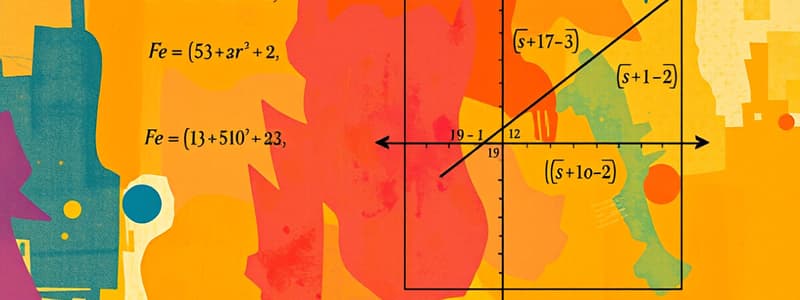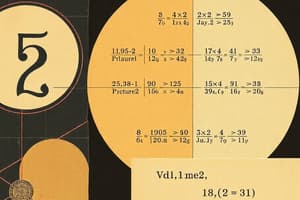Podcast
Questions and Answers
What is the slope-intercept form of a linear equation?
What is the slope-intercept form of a linear equation?
- y=bx+m
- y=m+b
- y=mx+b (correct)
- y=kx
In slope-intercept form, what does 'm' represent?
In slope-intercept form, what does 'm' represent?
slope
In slope-intercept form, what does 'b' represent?
In slope-intercept form, what does 'b' represent?
y-intercept
What is the formula for direct variation?
What is the formula for direct variation?
What is the formula to find the slope of a line between two points?
What is the formula to find the slope of a line between two points?
What is the formula for the circumference of a circle?
What is the formula for the circumference of a circle?
What is the area formula for a triangle?
What is the area formula for a triangle?
What is the area formula for a rectangle or parallelogram?
What is the area formula for a rectangle or parallelogram?
What is the area formula for a trapezoid?
What is the area formula for a trapezoid?
What is the area formula for a circle?
What is the area formula for a circle?
What is the lateral surface area formula of a prism?
What is the lateral surface area formula of a prism?
What is the lateral surface area formula of a cylinder?
What is the lateral surface area formula of a cylinder?
What is the total surface area formula of a prism?
What is the total surface area formula of a prism?
What is the total surface area formula of a cylinder?
What is the total surface area formula of a cylinder?
What is the formula for the volume of a prism?
What is the formula for the volume of a prism?
What is the formula for the volume of a pyramid?
What is the formula for the volume of a pyramid?
What is the formula for the volume of a sphere?
What is the formula for the volume of a sphere?
What is the Pythagorean Theorem?
What is the Pythagorean Theorem?
What is the formula for simple interest?
What is the formula for simple interest?
What is the formula for compound interest?
What is the formula for compound interest?
Flashcards are hidden until you start studying
Study Notes
Slope-Intercept Form
- Equation is expressed as y = mx + b.
- m represents the slope of the line.
- b indicates the y-intercept where the line crosses the y-axis.
Direct Variation
- Represented by the equation y = kx, where k is a constant.
Slope Calculation
- Formula for the slope (m) between two points (x1, y1) and (x2, y2) is m = (y2 - y1) / (x2 - x1).
Circle Measurements
- Circumference (C) can be calculated using C = 2πr (radius) or C = πd (diameter).
- Area (A) of a circle is given by A = πr².
Triangle and Rectangle Measurements
- Area of a triangle is calculated using A = 1/2 * base (b) * height (h).
- Area of a rectangle or parallelogram is A = base (b) * height (h).
Trapezoid Area
- The area of a trapezoid can be found using A = 1/2 * (b1 + b2) * height (h), where b1 and b2 are the lengths of the two parallel sides.
Prism and Cylinder Surface Areas
- Lateral surface area of a prism is S = Perimeter of base (P) * height (h).
- For a cylinder, lateral surface area is S = 2πr * height (h).
Total Surface Area Calculations
- Total surface area of a prism is S = Ph + 2B, where B is the area of the base.
- Total surface area of a cylinder is S = 2πrh + 2πr².
Volume Calculations
- Volume of a prism is calculated using V = Base area (B) * height (h).
- Volume of a pyramid is V = 1/3 * Base area (B) * height (h).
- Volume of a sphere is given by V = 4/3πr³.
Pythagorean Theorem
- Used to determine the relationship between the sides of a right triangle with the formula a² + b² = c², where c is the hypotenuse.
Interest Calculations
- Simple interest (I) is calculated using I = Principal (P) * rate (r) * time (t).
- Compound interest can be represented by the formula A = P(1 + r)ᵗ, where t is the number of compounding periods.
Studying That Suits You
Use AI to generate personalized quizzes and flashcards to suit your learning preferences.




